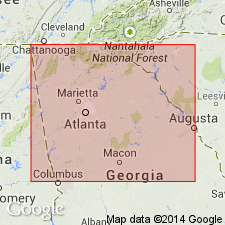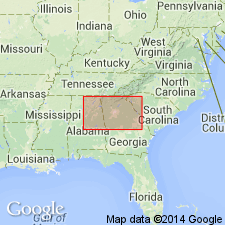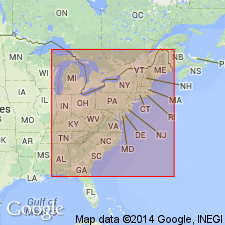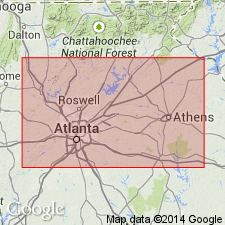
- Usage in publication:
-
- Austell granite
- Modifications:
-
- Redescribed
- Dominant lithology:
-
- Granite
- Gneiss
- AAPG geologic province:
-
- Piedmont-Blue Ridge province
Summary:
Pg. 41-42. Austell granite (credited to Hayes, 1901). Described as an augen gneiss. Closely resembles Corbin granite but lacks pyroxene. Abundant phenocrysts. Exposed in an elongate area extending from Austell, Cobb County, southwestward across Douglas County, into eastern Carroll County, northwestern Georgia. Age is Precambrian(?).
Source: US geologic names lexicon (USGS Bull. 1200, p. 173); supplemental information from GNU records (USGS DDS-6; Reston GNULEX).

- Usage in publication:
-
- Austell Gneiss*
- Modifications:
-
- Age modified
- Geochronologic dating
- Dominant lithology:
-
- Gneiss
- AAPG geologic province:
-
- Piedmont-Blue Ridge province
Summary:
The Austell Granite Gneiss of Hayes (1901), redefined the Austell Gneiss by Medlin and Crawford (1973), is accepted by the USGS. It is a metamorphosed and deformed pluton consisting of coarsely porphyritic quartz monzonite gneiss which occupies the 'nose' of the Austell-Frolona anticlinorium. It intrudes the Bill Arp and Zebulon Formations and has been overthrust by the Sandy Springs Group. Age is Early Silurian, about 431 m.y., based on Zr and Rb/Sr isochron ages (Arth and others, written commun., 1986).
Source: GNU records (USGS DDS-6; Reston GNULEX).

- Usage in publication:
-
- Austell Gneiss*
- Modifications:
-
- Geochronologic dating
- AAPG geologic province:
-
- Piedmont-Blue Ridge province
Summary:
Age of Austell Gneiss is based on Rb-Sr whole-rock isochron age of 432+/-8 Ma and a Pb-Pb age of 430 Ma (J. Arth, written commun., 1987).
Source: GNU records (USGS DDS-6; Reston GNULEX).

- Usage in publication:
-
- Austell Gneiss*
- Modifications:
-
- Revised
- AAPG geologic province:
-
- Piedmont-Blue Ridge province
Summary:
Early Silurian Austell Gneiss intrudes Bill Arp Formation and Gothards Creek Gneiss (new). Early Silurian age based on one U-Pb-Th date of about 430 Ma, zircon dates from 9 "splits" of two zircon samples, and six Rb/Sr whole-rock isochron ages of 432 +/-8 Ma. Report includes geologic map and correlation chart.
Source: GNU records (USGS DDS-6; Reston GNULEX).
For more information, please contact Nancy Stamm, Geologic Names Committee Secretary.
Asterisk (*) indicates published by U.S. Geological Survey authors.
"No current usage" (†) implies that a name has been abandoned or has fallen into disuse. Former usage and, if known, replacement name given in parentheses ( ).
Slash (/) indicates name conflicts with nomenclatural guidelines (CSN, 1933; ACSN, 1961, 1970; NACSN, 1983, 2005, 2021). May be explained within brackets ([ ]).

